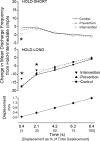Effect of spinal manipulation on the development of history-dependent responsiveness of lumbar paraspinal muscle spindles in the cat
- PMID: 24932019
- PMCID: PMC4045034
Effect of spinal manipulation on the development of history-dependent responsiveness of lumbar paraspinal muscle spindles in the cat
Abstract
We determined whether spinal manipulation could prevent and/or reverse the decrease and increase in paraspinal muscle spindle responsiveness caused respectively by lengthening and shortening histories of the lumbar muscles. Single unit spindle activity from multifidus and longissimus muscles was recorded in the L6 dorsal root in anesthetized cats. Muscle history was created and spinal manipulation delivered (thrust amplitude: 1.0mm, duration: 100ms) using a feedback-controlled motor attached to the L6 spinous process. Muscle spindle discharge to a fixed vertebral position (static test) and to vertebral movement (dynamic test) was evaluated following the lengthening and shortening histories. For the static test, changes in muscle spindle responsiveness were significantly less when spinal manipulation followed muscle history (p<0.01), but not when spinal manipulation preceded it (p>0.05). For the dynamic test, spinal manipulation did not significantly affect the history-induced change in muscle spindle responsiveness. Spinal manipulation may partially reverse the effects of muscle history on muscle spindle signaling of vertebral position.
Nous avons déterminé si les manipulations vertébrales pouvaient prévenir ou inverser la diminution et l’augmentation de la réactivité du fuseau musculaire paravertébral causé respectivement par les antécédents d’allongement et de raccourcissement des muscles lombaires. L’activité des fuseaux musculaires des muscles multifidus et longissimus prise isolément a été notée pour la racine dorsale de la vertèbre L6 chez des chats anesthésiés. Les muscles ont été soumis à un antécédent musculaire et la manipulation vertébrale a été effectuée (amplitude la pulsion : 1,0 mm, durée : 100 ms) au moyen d’un moteur contrôlé par rétroaction fixé à l’apophyse épineuse de L6. Les décharges du fuseau musculaire à une position vertébrale fixe (test statique) et au mouvement vertébral (test dynamique) ont été évaluées à la suite des antécédents d’allongement et de raccourcissement musculaires. Pour ce qui est du test statique, les changements dans la réactivité du fuseau musculaire étaient significativement moindres lorsque la manipulation vertébrale était effectuée après l’antécédent musculaire (p<0,01), ce qui n’était pas le cas lorsque la manipulation vertébrale la précédait (p>0,05). Pour ce qui est du test dynamique, la manipulation vertébrale n’a pas eu d’effet significatif sur le changement de la réactivité du fuseau musculaire provoqué par l’antécédent. La manipulation vertébrale peut partiellement inverser l’effet de l’antécédent musculaire sur la signalisation de la position vertébrale du fuseau musculaire.
Keywords: Muscle spindle; chiropractic; lumbar spine; muscle history; paraspinal muscle; proprioception; spinal manipulation; thixotropy.
Figures





References
-
- Farfan HF. The scientific basis of manipulation procedures. In: Buchanan WW, Kahn MF, Laine V, Rodnan GP, Scott JT, Zvaifler NJ, et al., editors. Clinics in rheumatic diseases. London: W.B. Saunders Company Ltd; 1980. pp. 159–77.
-
- Giles LGF. Anatomical Basis of Low Back Pain. Baltimore: Williams & Wilkins; 1989.
-
- Lewit K. Manipulative Therapy in Rehabilitation of the Locomotor System. Oxford: Butterworth-Heinemann; 1991.
-
- Haldeman S. The clinical basis for discussion of mechanisms of manipulative therapy. In: Korr IM, editor. The neurobiologic mechanisms in manipulative therapy. NY: Plenum; 1978. pp. 53–75.
-
- Vernon H. Biological rationale for possible benefits of spinal manipulation. 1997:105–115. AHCPR Publication No. 98-N002.
Grants and funding
LinkOut - more resources
Full Text Sources
Miscellaneous
